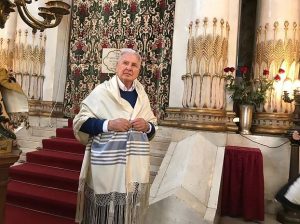Ever since I first wrote about the S&P tallet three or four years ago, I’ve been searching for a weaver who could create a tallit that closely reflects the old tradition, and along the way, several people who adhere to S&P customs have sent me inquiries.
Now, we’ve finally found it.
 If you’re unfamiliar with the basic features of the S&P tallet, allow me to set forth a quick description. It’s typically made of silk (sometimes wool) with long fringes or netted fringes, no atara and large decorated corner squares. The tzitzit are tied with a Sephardic spiral, in sections of 10, 5, 6 and 5 rather than the more common 7, 8, 11 and 13 pattern. The striping is often blue rather than black or white stripes. And the size is somewhere around 30-40 inches high, so that it is worn wrapped around the arms with all four corners held in front, similar to the way German Jews and Yemenite Jews wear a tallit as a wrap or “ituf” (see here and here).
If you’re unfamiliar with the basic features of the S&P tallet, allow me to set forth a quick description. It’s typically made of silk (sometimes wool) with long fringes or netted fringes, no atara and large decorated corner squares. The tzitzit are tied with a Sephardic spiral, in sections of 10, 5, 6 and 5 rather than the more common 7, 8, 11 and 13 pattern. The striping is often blue rather than black or white stripes. And the size is somewhere around 30-40 inches high, so that it is worn wrapped around the arms with all four corners held in front, similar to the way German Jews and Yemenite Jews wear a tallit as a wrap or “ituf” (see here and here).
Similar tallits were found in Italy until about 50 years ago.
For more information and pricing, click here.


(2) Comments
Tefillin prices for a tallit? I just don’t get it. It’s because they’re silk and a niche item. These would be considered pretty halakhically irregular, because for an ‘ituf’ all the authorities ruled that you should be wearing wool, and it definitely has to be larger than scarf size. I have a sense that the Jews living in that part of the world actually had an easier time acquiring silk than wool in the old days, maybe not many sheep, unlike Turkey where the thickest wool was the thing. Lastly, the pretentious looking fringe-ends are so big they detract attention from the fringe that matters: the tzitzit.
You make some excellent points, which I’d like to address one-by-one. The tallit prices most people are used to, say $100-$200, are for mass production tallits, whereas prices for hand-woven tallits are always significantly more, because you have a professional weaver sitting at a loom all day. Also, netted fringes always add $40-$50 to the price, because they are done by hand. (A few factory-made wool tallits are also available with netted fringes.) This tallit has superb European craftsmanship, so it’s not priced like bottom-end hand-woven tallits. There is a US manufacturer that announced plans some two years ago to create an affordable S&P tallit, but so far those plans have not come to fruition.
It sounds to me like you may be confusing two issues: ‘ituf’ relates to how a tallit should be worn, whereas your contention about wool vs. silk relates to what material a tallit should be made of. So let’s take a look at these issues one at a time.
The proper way to do ituf is not cut-and-dry. The arguments in favor of wrapping it around with all four corners hanging in front are quite strong, in my opinion, and we find an age-old custom, followed to the present day, to wear a tallit in that manner not just among Western Sephardic Jews, but also among German Jews and Yemenite Jews.
The size of the S&P tallit is definitely not an issue, since it’s not at all narrow like a scarf. The leading halachic authorities rule that the minimum size is 20 inches (Grach Na’eh), 22 inches (Rabbi Moshe Feinstein) or 24 inches (Chazon Ish). This tallit is 36 inches.
You write that we should be wearing wool. There are a whole lot of upstanding Jews who wear a cotton tallit katan. Both the Vilna Gaon and the Chazon Ish wore a cotton tallit katan. Had they been offered a high-quality cotton or silk tallit gadol, would they have chosen to wear it? I cannot say.
Do the netted fringes detract from the tzitzit? Perhaps some people would say they embellish the tzitzit. Note that Yemenite Jews have worn a tallit with netted fringes for centuries.
Comments are closed.